GREENSBORO, N.C. — With smoke alarms becoming more prevalent and better building codes, the number of house fires reported in the U.S. has dropped by half since 1980. That’s the good news. The bad news is that the fires that do happen are much deadlier, with the number of deaths rising since 2010.
House fires today burn faster and hotter, and they’re deadlier than ever. But why? One main reason is time.
"Forty years ago, you would have had about 17 minutes to get out of a house on fire. But today you have just 3 minutes," said John Galeotafiore, Consumer Reports.
So what’s changed? In part, those popular open-plan houses. With fewer walls and doors, fires travel faster and more freely.
Another culprit is today’s furniture.
" A lot of homes today have furnishings made with synthetic materials like plastic or particleboard, which burn much quicker than, say, solid wood," said Galeotafiore.
Some classic advice still holds true today. Have at least one smoke detector and one class “ABC” fire extinguisher per floor of your home, and check them monthly.
Consumer Reports recommends the dual-sensor alarms from First Alert and Kidde. Both got perfect scores for detecting both flaming and smoldering fires.
CHECK THESE ITEMS:
Don’t leave lithium-ion batteries, like the ones for your power tools, charging overnight, and be sure to only use the charger that came with it.
If you have an outlet that doesn’t grip the plug, it’s time to change it. Replace your worn-out outlets with an arc-fault circuit interrupter, also known as an AFCI outlet.
And have an escape plan in place and rehearse it with everyone in your household.
DON'T MISS THIS:
CR also recommends keeping your bedroom door closed at night. That can help keep fires from spreading.

